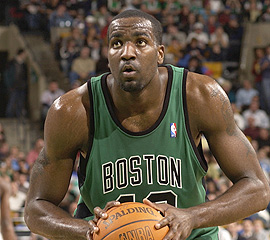Celtics Kendrick Perkins injured in Game 6

Boston Celtics center Kendrick Perkins left Game 6 of the NBA finals when he landed awkwardly when he went up for an offensive rebound about 10 minutes into the first quarter. He laid on the floor clutching his knee and had to helped off the court. Xrays revealed that he suffered sprains to both his medial collateral ligament and posterior cruciate ligament. It is unknown whether he will be able to play in Game 7 on Thursday.
“Perk brings rebounding and defense to the game, and toughness,” said Celtics captain Paul Pierce. “We lose that, but that’s not an excuse. We’re a mentally tough team. We’ve had injuries all year that we’ve dealt with. We know how to win when guys go down, so that’s no excuse for us.”
A sprain is an injury to the ligaments (thick bands of cartilage that connect bone to bone)caused by a fall or outside force that pulls the surrounding joint beyond its normal range of movement. The degree of sprain can range from a stretched ligament to a completely torn ligament.
 The knee is essentially a modified hinge joint located where the end of the thigh bone (femur) meets the top of the shin bone(tibia). Four main ligaments connect these two bones:
The knee is essentially a modified hinge joint located where the end of the thigh bone (femur) meets the top of the shin bone(tibia). Four main ligaments connect these two bones:
- Medial collateral ligament (MCL) — runs along the inner part of the knee and prevents the knee from bending inward.
- Lateral collateral ligament (LCL) — runs along the outer part of the knee and prevents the knee from bending outward.
- Anterior cruciate ligament (ACL) — lies in the middle of the knee. It prevents the tibia from sliding out in front of the femur,and provides rotational stability to the knee.
- Posterior cruciate ligament (PCL) — works with the ACL. It prevents the tibia from sliding backwards under the femur.
The ACL and PCL cross each other inside the knee, forming an “X.”
Cruciate ligament injuries are sometimes referred to as sprains. They don’t necessarily cause pain, but they are disabling. The anterior cruciate ligament is most often stretched or torn (or both) by a sudden twisting motion (for example, when the feet are planted one way and the knees are turned another). The posterior cruciate ligament is most often injured by a direct impact, such as in an automobile accident or football tackle. If a cruciate ligament is injured, you may hear a popping sound, and the leg may buckle when you try to stand on it.
The medial collateral ligament is more easily injured than the lateral collateral ligament. The cause of collateral ligament injuries is most often a blow to the outer side of the knee that stretches and tears the ligament on the inner side of the knee. Such blows frequently occur in contact sports such as football or hockey. When injury to the medial collateral ligament occurs, you may feel a pop and the knee may buckle sideways. Pain and swelling are common.
As with most such injuries, care immediately after the injury consists of RICE therapy-
Rest, Ice, Compression, and Elevation). Medical attention should be sought to thoroughly evaluate the injury. If the injury is mild and not completely through the entire ligament, conservative management including immobilization with a knee brace and physical therapy may surfice. If the ligament is completely torn, it can not be repaired, but must be replaced, usually during arthroscopic surgery.
For more information:
| Resounding Health(tm) Knee Problems |

























0 comments